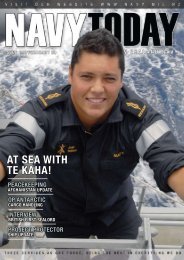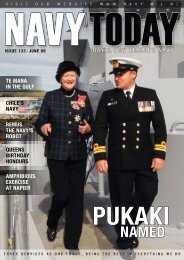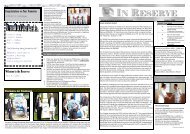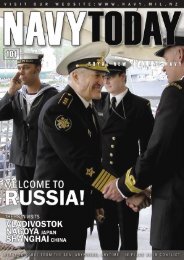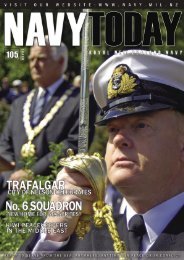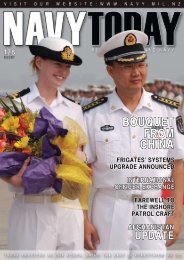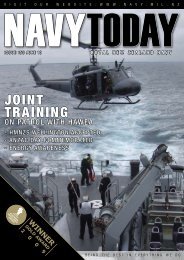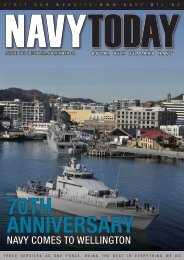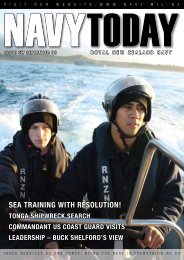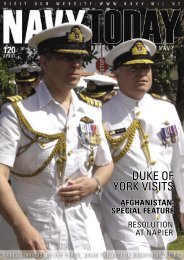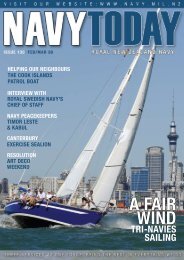CANTERBURY! HMNZS - Royal New Zealand Navy
CANTERBURY! HMNZS - Royal New Zealand Navy
CANTERBURY! HMNZS - Royal New Zealand Navy
- No tags were found...
Create successful ePaper yourself
Turn your PDF publications into a flip-book with our unique Google optimized e-Paper software.
FLEET PROGRESS<strong>HMNZS</strong> TE KAHANAVAL PATROL FORCEAnzac Day at Te Kaha was characterised byfood, good company and relaxed reflection. Itbegan with a dawn ceremony at the Marae,followed by a breakfast reception at the localRSA. The main service was at the OmaioMarae, approximately ten minutes drive fromTe Kaha. What made this more special wasthe presence of an original Canteen Truck,used by 28 (Maori) Battalion in North AfricaCIM COURSEBY SLT LORNA GRAYFOR one long week of what seemed like eternity (but was actually quiteduring WWII. (Many of that famous battalionwere from the East Coast so the truck, on anational tour, and its drivers were given anemotional welcome.)After the service, the Kai! POCSS Cateralllooked especially wide-eyed as the doorswere opened to the Wharekai revealing crayfish,paua, smoked fish and other kai moanaas well as wild pig from the hangi, and othergood fun) thirteen volunteers from TE KAHA attended the Critical IncidentManagement (CIM) course. Each day lasted for about seven hours – giveor take an hour depending on how quick on the uptake we were – so adetailed list of everything we did would be too extensive. In a nutshellthough, the course covered self defence, some groundwork, arm and wristlocks, constraint and arrest, and search techniques. The most importantthing we learnt during the period of our course, however, is that having‘presence’ is crucial.The course culminated in what is known by many names but is forgottenby no one. Call it the “Mad Minute” or the “Red Man” whatever, it isall the same – one minute of utilising presence, voice and finally the ASPbaton to full advantage against a padded instructor followed by a secondminute, boxing gloves on, using every dirty playground trick in the bookto repel the attacks of our extremely zealous instructor. Any ideas of beingRocky Balboa go out the window as soon as his first punch collideswith your head!ABOVE: LT Chris Mills speaking on theMarae. LEFT: Looking out over the Bay ofPlenty from Te Kahalocal delicacies. We all added a few inchesto our waistlines! Our experience at Te Kahaon Anzac Day was special - the hospitalityshown by the whole town reaffirmed thespecial bond between the ship and communityand is a relationship which is bound togrow in the future. There is already a outriggercanoe challenge in place, for when ourship anchors off sometime in the future!I can’t imagine CIM training ever being a walk in the park but certainlyhaving a reasonable level of fitness goes a long way to makingit slightly more comfortable. That, and having an arm that can takebeing bent backwards!For potential Boarding Team members this course is vital but it wouldalso provide practical information for all Naval personnel, especiallythose who are sea-going.It relates well to our ROE, supplies course members with worthwhileclose quarters combat knowledge and equips people with theunderstanding of how to respond to someone – dangerous, potentiallydangerous or even completely harmless.We weren’t Gunners, or anyone special. In fact our instructor, an exPOSCS, called us the “stores” bunch (I couldn’t figure out if that wasan insult or not) but we all passed, and did really well.As Jamie said, often it is not a matter of how big you are but howmuch heart you put into it. None of us were Kung Fu experts (not thatthat would have helped) but we came away with essential knowledgeon how to beat any shortcomings and most importantly, how to takecontrol of a situation. Whether peace-keeping overseas or beingbrow staff in DNB, this is one worthwhile course that lasts for onehelluva week.SLT Rob Morrison and ENS Tom Cooke take bearings from the bridge wing of WAKAKURAKIWI & WAKAKURA REPORTSLT MANDY RICHARDS RNZNAND MID JAE STAITE RNZNAFTER the change of command ceremoniesat the end of May [see NT 122] June sawKIWI and WAKAKURA departing DNB in supportof the Grade 2 OOW course.Throughout the two weeks of the seaphase, the OOW students conductedOOWMANS, TOWEX and MOBEX drillsand numerous pilotage runs, both duringthe day and at night. The watch keeperswere put through their paces during theseassessments, under the close scrutiny ofthe CO and the assessing Officer. The aimwas to develop the students’ practical skills,thought processes and decision-making.After pilotage runs in and out of AucklandHarbour and around Waiheke Island, bothships headed up the coast to Whangarei.Here the watch keepers had to tackle pilotagethrough the long and rather narrowharbour/estuary, with an unexpected bargeanchored in the centre of the already narrowchannel, and several markers being astray.The night pilotage in Whangarei was evenmore challenging, with intense concentrationrequired to assess the position andsafety of the respective ships. After someshaky starts, the students developed impressivetiming and accuracy in their execution.The second week began with KIWI andWAKAKURA undertaking a TOWEX withMANAWANUI - both ships managing totow the much larger ship at an impressive2 knots!Next day we again headed to Whangarei,but here KIWI lost her port engine. Acracked crank case – a major defect to testthe engineers. The decision was made forKIWI to head back to DNB on one engine,while WAKAKURA continued as planned inWhangarei, then embarked the studentsWAKAKURA passes close alongside the old <strong>CANTERBURY</strong>.The frigate is due to be sunk as a dive wreck in October.from KIWI so they could make up for whatthey had lost by returning early.The following week WAKAKURA undertookOp RAPANGA, with two Customs Officersembarked. The area for the operation wasthe Bay of Islands, where the aim was tolocate and identify all vessels arriving ordeparting the east coast North Island andto intercept any vessels as required. Onevessel was found to be not conforming tothe NZ Customs and Excise Act, and wassubsequently boarded by the Customs Officersand given a formal warning.Overall WAKAKURA had a successful patrol- a highlight for all on board was getting upclose to the decommissioned frigate CAN-TERBURY at Opua Wharf (where the old frigateis being prepared as a dive wreck).Once alongside at DNB the next Friday, 15VR personnel from NGAPONA, PEGASUSand OLPHERT were embarked in WAKAKU-RA for a sea training weekend. This wasmostly focussed on seamanship evolutions,the priority being for those VR personnelon their Able Seaman course. Seasprite 04came out on the Saturday and conducted aWINCHEX serial which saw the majority ofthe VR’s getting a chance to be winched. Thiswas enjoyed by all – really!KIWI’s port engine defects required herto go up on the lift and she was due to beoperational again on 8 July. With the enginerepaired, her tasking for this month (July)is to conduct a Maritime Fisheries Patrol inthe Bay of Plenty. WAKAKURA has movedinto a week of IMAV followed by a 2 weekleave period.28 NT123JULY07 WWW.NAVY.MIL.NZWWW.NAVY.MIL.NZNT123JULY07 29



